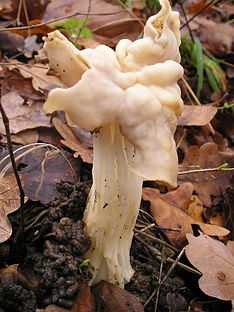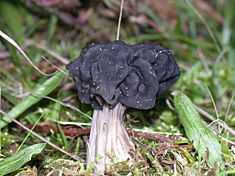Helvella
| Helvella | |
|---|---|
 | |
| Helvella crispa | |
| Scientific classification | |
| Kingdom: | Fungi |
| Division: | Ascomycota |
| Subdivision: | Pezizomycotina |
| Class: | Pezizomycetes |
| Order: | Pezizales |
| Family: | Helvellaceae |
| Genus: | Helvella Fr. |
| Type species | |
| Helvella crispa (Scop.) Fr. (1822) | |
Helvella is a genus of ascomycete fungus of the Helvellaceae family. The mushrooms, commonly known as elfin saddles, are identified by their irregularly shaped caps, fluted stems, and fuzzy undersurfaces. They are found in North America and in Europe. Well known species include the whitish H. crispa and the grey H. lacunosa. They have been reported to cause gastrointestinal symptoms when eaten raw.[1]
The generic name was originally a type of Italian herb but became associated with morels.[2]
Description
Species in Helvella have fruiting bodies (technically ascocarps) that grow above the ground, and usually have stems. The cup-like fruiting body (the apothecium) can assume a variety of forms: it may be shaped like an ear (auriculate), or a saddle; it may be convex or irregularly lobed and bent. The spore-bearing surface, the hymenium, can be smooth, wavy or wrinkled and can range in color from white to black or various shades of gray or brown. Similarly, the outer surface of the fruiting bodies can be smooth, ribbed, or have minute hairlike projections (villi). The stem is cylindrical and tapering or grooved and ribbed. The flesh is usually between 1–2 mm thick.[3]
Species
- Helvella acetabulum
- Helvella albella
- Helvella albipes
- Helvella atra
- Helvella confusa
- Helvella corium
- Helvella costifera
- Helvella crispa
- Helvella cupuliformis
- Helvella dissingi
- Helvella dryophila[4]
- Helvella elastica
- Helvella engleriana
- Helvella ephippium
- Helvella fibrosa[5]
- Helvella fusca
- Helvella griseoalba
- Helvella juniperi[6]
- Helvella lacunosa
 H. lacunosa
H. lacunosa - Helvella latispora
- Helvella leucomelaena[7]
- Helvella leucopus
- Helvella macropus
- Helvella monachella
- Helvella pezizoides
- Helvella phlebophora
- Helvella queletii
- Helvella silvicola
- Helvella solitaria
- Helvella subglabra
- Helvella terrestris[8]
- Helvella vespertina[4]
- Helvella zhongtiaoensis[9]
See also
| Wikimedia Commons has media related to Helvella. |
References
- ↑ Ammirati, Joseph F.; Traquair, James A.; Horgen, Paul A. (1985). Poisonous mushrooms of the northern United States and Canada. Minneapolis: University of Minnesota Press. p. 259. ISBN 0-8166-1407-5.
- ↑ Nilsson S, Persson O.(1977) Fungi of Northern Europe 1: Larger Fungi (Excluding Gill Fungi). pp. 36-37. Penguin Books. ISBN 0-14-063005-8
- ↑ Abbott SP, Currah RS. (1997). "The Helvellaceae: systematic revision and occurrence in northern and northwestern North America". Mycotaxon 62: 1–125.
- ↑ 4.0 4.1 Nguyen NH, Landeros F, Garibay-Orijel R, Hansen K, Vellinga EC. (2013). "The Helvella lacunosa species complex in western North America: cryptic species, misapplied names and parasites". Mycologia 105 (5): 1275–86. doi:10.3852/12-391. PMID 23709487.
- ↑ Korf RP. (2008). "Nomenclatural notes. 12. Untangling hedwig's Octospora villosa: Helvella fibrosa comb. nov". Mycotaxon 103: 307–12.
- ↑ Filippa M, Baiano G. (1999). "Helvella juniperi sp. nov. new species collected on the Tyrrhenian coast". Rivista di Micologia (in Italian) 42 (2): 99–118.
- ↑ Asef, M.R. (2013) The genus Helvella in Iran. Mycologia Iranica. 1(1). 9-13
- ↑ Landvik, Sara; Kristiansen, Roy; Schumacher, Trond (1999). "Pindara: a miniature Helvella". Mycologia 91 (2): 278–85. doi:10.2307/3761373. JSTOR 3761373.
- ↑ Cao J-Z, Liu B. (1990). "A new species of Helvella from China". Mycotaxon 82 (5): 642–43. doi:10.2307/3760054.